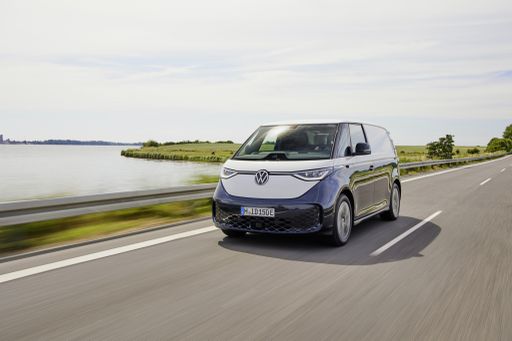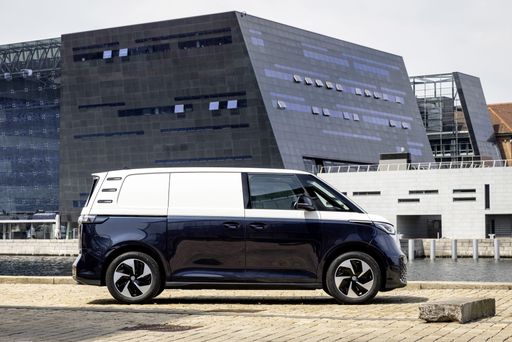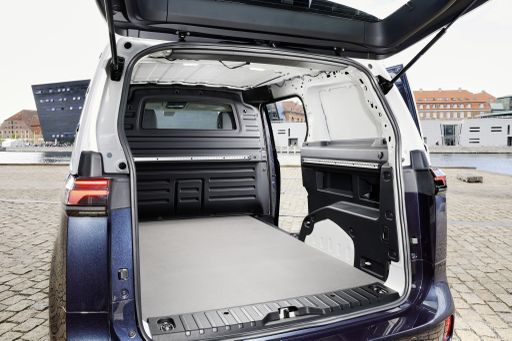VW ID. Buzz Cargo VS Kia PV5 – Porównanie danych technicznych, wydajności i ceny
Sprawdź, który samochód lepiej spełni Twoje oczekiwania!
Model VW ID. Buzz Cargo (Van) jest wyposażony w silnik Elektryczny i skrzynię Automatyczna. Dla porównania, Kia PV5 (Van albo Bus) ma silnik Elektryczny i przekładnię Automatyczna.
Jeśli chodzi o pojemność bagażnika, VW ID. Buzz Cargo oferuje , natomiast Kia PV5 zapewnia 1320 L – wszystko zależy od Twoich potrzeb. Jeśli szukasz większej mocy, zdecyduj, czy 340 KM w VW ID. Buzz Cargo czy 163 KM w Kia PV5 będzie dla Ciebie lepszy.
Są też różnice w zużyciu energii/paliwa: 19.20 kWh vs 19.80 kWh. Pod względem ceny, VW ID. Buzz Cargo zaczyna się od 223300 zł, a Kia PV5 jest dostępny od 168200 zł.
Porównaj wszystkie kluczowe parametry i sprawdź, który model najlepiej pasuje do Twojego stylu życia!
In the burgeoning electric van segment, the VW ID. Buzz Cargo and the Kia PV5 stand out with their unique offerings. The ID. Buzz Cargo captivates with its nostalgic design that nods to Volkswagen's iconic microbus, while packing in modern tech and ample cargo space. Meanwhile, the Kia PV5 impresses with its forward-thinking approach, boasting advanced green technology, strong efficiency, and an expansive interior, making it a formidable contender for eco-conscious businesses.
VW ID. Buzz Cargo
ID. Buzz Transporter to nowoczesna reinterpretacja klasycznego modelu Volkswagena, łącząca w sobie styl retro z nowoczesnością. Jego przestronność i wszechstronność sprawiają, że doskonale nadaje się zarówno do codziennych dojazdów, jak i na rodzinne wycieczki. Ekologiczny napęd elektryczny dodatkowo podkreśla zaangażowanie producenta w zrównoważony rozwój i ochronę środowiska.
szczegóły @ volkswagen-newsroom.com
@ volkswagen-newsroom.com
 @ volkswagen-newsroom.com
@ volkswagen-newsroom.com
 @ volkswagen-newsroom.com
@ volkswagen-newsroom.com
Kia PV5
The Kia EV5 is an exciting new entrant in the landscape of electric SUVs, promising a blend of style and innovation that captures attention. It boasts a sleek and modern design that aligns with Kia's evolving aesthetic identity, blending practicality with eye-catching details. With its foray into the electric vehicle segment, the EV5 is set to offer a highly competitive option for those looking to embrace sustainable mobility without compromising on comfort or tech features.
szczegółyElectric Cargo Vans Face-Off: VW ID. Buzz Cargo vs. Kia PV5
The electric cargo van market has taken off as businesses seek sustainable solutions for their logistical needs. Leading the charge are the freshly minted VW ID. Buzz Cargo and the Kia PV5, two electric vehicles that promise to revolutionize the way goods are transported. In this article, we delve into the details, comparing both the technical prowess and innovative features of these electrifying entrants.
Performance and Powertrain
The VW ID. Buzz Cargo boasts an impressive array of power options, with outputs ranging from 170 HP to a powerful 340 HP. The electric motor can drive either the rear or all wheels, catering to a variety of business needs. Its exceptional torque, available in 310 Nm, 560 Nm, and a hefty 679 Nm, ensures that even the heaviest loads are transported with ease.
In contrast, the Kia PV5 is focused on efficiency and practicality, featuring a front-wheel-drive system powered by electric motors producing either 121 HP or 163 HP. While it may not match the ID. Buzz's raw power, with a consistent 250 Nm torque, the PV5 is no slouch, offering reliable performance for urban deliveries.
Range and Efficiency
Long-distance driving is a breeze for the VW ID. Buzz Cargo, equipped with a battery capacity of either 59 kWh or 79 kWh, translating to an impressive electric range between 330 km and 455 km, depending on configuration. The efficiency is remarkable, with a consumption rate as low as 19.2 kWh/100km.
The Kia PV5 holds its own in terms of range, offering battery packs of 51.5 kWh and 71.2 kWh. It achieves a slightly lower top range of up to 400 km on a single charge. Its energy consumption ranges from 19.8 kWh/100 km to 20.3 kWh/100 km, making it a reliable partner for localized operations.
Design and Dimensions
Function meets form in the VW ID. Buzz Cargo with its unique design. At 4712 mm long, 1985 mm wide, and 1932 mm high, it combines the iconic VW aesthetic with cargo functionality, offering payload capacities between 640 kg and 753 kg.
The Kia PV5 is slightly more compact at 4695 mm long, featuring widths of 1850 mm or 1895 mm and a height of 1923 mm. It emphasizes versatility, offering van or bus configurations with payload capacities between 505 kg and 790 kg.
Modern Innovations
The VW ID. Buzz Cargo shines with its advanced all-wheel drive system option, providing superior control and adaptability in diverse driving conditions. Its zero emissions ensure it meets stringent environmental standards, earning it an 'A' CO2 efficiency class.
The Kia PV5 stands out with its reduction gearbox, optimizing power for urban driving scenarios. Its focus on efficiency also earns it an 'A' CO2 efficiency class, aligning with modern ecological demands.
Conclusion
The VW ID. Buzz Cargo and Kia PV5 both offer compelling propositions for businesses looking to electrify their fleets. The ID. Buzz Cargo offers superior power options and range, while the PV5 offers efficiency and flexibility in a compact package. Ultimately, the choice between these two will depend on specific business needs and preferences. As these models take to the streets, they promise not only to enhance delivery efficiency but to substantially reduce carbon footprints, paving the way for a cleaner automotive future.

|
|
|
|
|
Koszty i Zużycie |
|
|---|---|
|
Cena
223300 - 263200 zł
|
Cena
168200 - 199400 zł
|
|
Zużycie L/100km
-
|
Zużycie L/100km
-
|
|
Zużycie kWh/100km
19.2 - 20.3 kWh
|
Zużycie kWh/100km
19.8 - 20.3 kWh
|
|
Zasięg elektryczny
330 - 455 km
|
Zasięg elektryczny
288 - 400 km
|
|
Pojemność baterii
59 - 79 kWh
|
Pojemność baterii
51.5 - 71.2 kWh
|
|
CO2
0 g/km
|
CO2
0 g/km
|
|
Pojemność zbiornika paliwa
-
|
Pojemność zbiornika paliwa
-
|
Wymiary i Nadwozie |
|
|---|---|
|
Typ nadwozia
Van
|
Typ nadwozia
Van, Bus
|
|
Miejsca siedzące
3
|
Miejsca siedzące
2 - 5
|
|
Drzwi
4
|
Drzwi
4 - 5
|
|
Masa własna
2264 - 2510 kg
|
Masa własna
1860 - 2145 kg
|
|
Pojemność bagażnika
-
|
Pojemność bagażnika
1320 L
|
|
Długość
4712 mm
|
Długość
4695 mm
|
|
Szerokość
1985 mm
|
Szerokość
1850 - 1895 mm
|
|
Wysokość
1932 mm
|
Wysokość
1923 mm
|
|
Ładowność
640 - 753 kg
|
Ładowność
505 - 790 kg
|
Silnik i Wydajność |
|
|---|---|
|
Typ silnika
Elektryczny
|
Typ silnika
Elektryczny
|
|
Skrzynia biegów
Automatyczna
|
Skrzynia biegów
Automatyczna
|
|
Szczegóły skrzyni biegów
-
|
Szczegóły skrzyni biegów
Reduktor
|
|
Rodzaj napędu
Napęd na tylne koła, Napęd na cztery koła
|
Rodzaj napędu
Napęd na przednie koła
|
|
Moc KM
170 - 340 KM
|
Moc KM
121 - 163 KM
|
|
Przyspieszenie 0-100km/h
-
|
Przyspieszenie 0-100km/h
10.7 - 16.3 s
|
|
Maksymalna prędkość
145 - 160 km/h
|
Maksymalna prędkość
135 km/h
|
|
Moment obrotowy
310 - 679 Nm
|
Moment obrotowy
250 Nm
|
|
Liczba cylindrów
-
|
Liczba cylindrów
-
|
|
Moc kW
125 - 250 kW
|
Moc kW
89 - 120 kW
|
|
Pojemność silnika
-
|
Pojemność silnika
-
|
Ogólne |
|
|---|---|
|
Rok modelowy
2024
|
Rok modelowy
2025
|
|
Klasa efektywności CO2
A
|
Klasa efektywności CO2
A
|
|
Marka
VW
|
Marka
Kia
|
VW ID. Buzz Cargo
Nowa era elektromobilności: VW ID. Buzz Transporter
Wielu z nas marzy o pojazdach, które łączą nowoczesne technologie z praktycznością. Volkswagen, wprowadzając model ID. Buzz Transporter, spełnia te oczekiwania, oferując elektryczny transporter, który nie tylko wygląda stylowo, ale również jest przyjazny dla środowiska i niezwykle funkcjonalny.
Design i ergonomia
VW ID. Buzz Transporter przyciąga wzrok swoim retro-futurystycznym wyglądem, łącząc klasyczne elementy z nowoczesnym designem. Jego wymiary – długość 4712 mm, szerokość 1985 mm oraz wysokość 1932 mm – zapewniają przestronność i komfort. Dzięki czterem drzwiom i pojemnemu wnętrzu, modele Cargo mogą pomieścić różne ładunki, co czyni go idealnym rozwiązaniem dla przedsiębiorców.
Silnik i osiągi
Na rynku dostępne są różne wersje ID. Buzz Transporter, w tym modele z napędem na tylne oraz wszystkie koła. Przykładowo, model z napędem na tylne koła ma moc 286 KM i zasięg 461 km na jednym ładowaniu, a wersja z napędem na wszystkie koła osiąga moc 340 KM, oferując zasięg 432 km. Obie wersje wyposażone są w nowoczesne akumulatory, które pozwalają na jednoczesne utrzymanie wysokiej wydajności i niskiego zużycia energii, jak wynika z ich efektywności – odpowiednio 19.2 kWh i 20.3 kWh na 100 km.
Innowacyjna technologia napędu
W VW ID. Buzz Transporter zastosowano nowoczesną przekładnię automatyczną i zredukowaną skrzynię biegów, co uczyniło jazdę nie tylko bardziej komfortową, ale także przyjemniejszą. Elektryczny proces napędowy gwarantuje brak emisji CO2, a klasa efektywności CO2 A podkreśla odpowiedzialność ekologiczną pojazdu.
Bezpieczeństwo i wyposażenie
Bezpieczeństwo i komfort jazdy są kluczowe w każdym nowoczesnym samochodzie. ID. Buzz Transporter jest wyposażony w zaawansowane systemy wspomagania kierowcy, a także oferuje przestronne wnętrze, które zaprojektowano z myślą o wygodzie. Model ten pomieści do trzech osób, co czyni go praktycznym rozwiązaniem zarówno dla użytkowników indywidualnych, jak i dla małych przedsiębiorców.
Podsumowanie
Volkswagen ID. Buzz Transporter to innowacyjne połączenie tradycji z nowoczesnością. Jego elektryczna jednostka napędowa, wysoka moc oraz zastosowanie najnowszych technologii zapewniają wyjątkowe osiągi i komfort jazdy. Model ten jest wyjątkowym narzędziem zarówno dla przedsiębiorców poszukujących efektywnego transportu, jak i dla osób pragnących dbać o środowisko. W erze elektronicznej mobilności, ID. Buzz Transporter staje się nowym standardem.
Kia PV5
A Fresh Perspective on Cargo Vans: The Kia PV5
The Kia PV5 stands as a beacon of innovation in the realm of electric cargo vans. Known for its forward-thinking design and practicality, this model sets a new standard in its class. The PV5 combines cutting-edge technology with an eco-friendly design, redefining the expectations for businesses seeking sustainable transportation solutions.
Electric Power Meets Efficiency
At the heart of the Kia PV5 lies an advanced electric powertrain. The model is equipped with a 51.5 kWh battery, offering an impressive electric range of 291 km on a single charge. This robust power supply pairs with a front-wheel-drive system powered by an electric motor that delivers 121 HP (equivalent to 89 kW), keeping the operations both smooth and efficient.
Sustainability Without Compromise
The commitment to sustainability is evident in the PV5’s zero emissions, with a CO2 output of 0 g/km. The van maintains a CO2 Efficiency Class of A, clearly demonstrating Kia’s dedication to reducing the environmental impact of its vehicles. Businesses adopting the PV5 can confidently promote their green credentials while benefiting from the cost savings associated with electric driving.
Designed for Modern Business Needs
The Kia PV5 Cargo L2H1 Electric Automatic model is engineered for functionality and ease of use. Its spacious design accommodates two seats and offers a generous cargo area, making it perfect for diverse delivery needs. The van spans 4695 mm in length, 1850 mm in width, and 1923 mm in height, providing ample space to maneuver goods with ease.
Performance and Practicality
In terms of performance, the PV5 boasts a torque of 250 Nm and can accelerate from 0 to 100 km/h in 16.3 seconds. While its top speed is capped at 135 km/h, this is more than sufficient for urban and suburban delivery routes. The reduction gearbox ensures smooth transitions as it navigates through daily tasks.
Safety and Innovation
Safety is not compromised with the Kia PV5. It features a suite of safety technologies that support the driver in maintaining control and avoiding incidents. These innovations not only contribute to the safety of the driver and cargo but also offer peace of mind to businesses that prioritize the wellbeing of their workforce and goods.
The Road Ahead for Kia PV5
As the automotive industry continues to move towards electrification, the Kia PV5 exemplifies how cargo vans can adapt to this change seamlessly. It represents an essential step towards more sustainable business operations, providing a viable and efficient option for companies looking to reduce their carbon footprint while enhancing operational efficiency. The Kia PV5 is more than just a vehicle; it’s a strategic asset for any forward-thinking business.
Jakie rodzaje napędu są dostępne dla VW ID. Buzz Cargo?
Dostępny jako Napęd na tylne koła albo Napęd na cztery koła.
Wyświetlane ceny i dane są szacunkowe, oparte na niemieckich cenach katalogowych i mogą się różnić w zależności od kraju. Te informacje nie stanowią wiążącej oferty.
